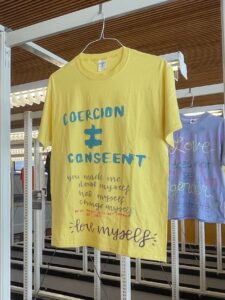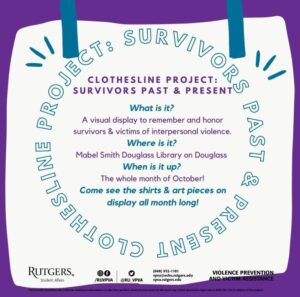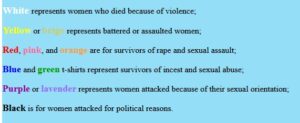 If you are walking around in Douglass Library in these days, you will see an astonishing, colorful display of T-shirts in the “catwalk,” i.e., the elevated exhibit platform on the ground floor, also known as the collaborative study section. Presented by Rutgers University Office for Violence Prevention and Victim Assistance, the exhibit, dubbed “Clothesline Project: Survivors Past and Present,” aims to support and honor survivors and victims of interpersonal violence throughout the month of October.
If you are walking around in Douglass Library in these days, you will see an astonishing, colorful display of T-shirts in the “catwalk,” i.e., the elevated exhibit platform on the ground floor, also known as the collaborative study section. Presented by Rutgers University Office for Violence Prevention and Victim Assistance, the exhibit, dubbed “Clothesline Project: Survivors Past and Present,” aims to support and honor survivors and victims of interpersonal violence throughout the month of October.
The decorated T-shirts and accompanying artwork are in line with similar displays featured in open spaces, including university campuses, since 1990. It was artist Rachel Carey-Harper who came up with the idea of hanging color-coded T-shirts on a clothesline in a public place to point out violence against women after she made the shocking discovery that while 58,000 soldiers died in the Vietnam War; 51,000 women were killed around the same time by men who claimed to love them. Read more about the history in the Wikipedia entry.
“Gender violence is a topic that touches all of us, regardless of one’s nationality, race, gender, sexuality, religion, etc. This exhibition in collaboration with the VPVA is a way for the Libraries to participate in the advocacy against gender violence, raising awareness among library users” – says Kayo Denda, Head, Margery Somers Foster Center & Librarian for Women’s, Gender & Sexuality Studies, Rutgers University – New Brunswick Libraries, who was instrumental in bringing the exhibit to the Mabel Smith Douglass Library.
The Clothesline Project National Network details the significance of each color. Its author later composed the poem “A Few Lines on the Clothesline Project” after “making my T-shirt and realizing that I had run out of colors to name all of the types of violence I had experienced.”

Rutgers has a long tradition of hosting events to design these T-shirts, mostly as a an outdoor, one-day creative program on the College Avenue Campus. This is the first time these T-shirts have been put on display for a whole month inside a library, which proves that libraries are so much more than just books!
Join us and browse the T-shirts and art in Douglass Library or in this online photo gallery.
CONTENT WARNING: Some of the images may be upsetting to view. The texts may contain graphic content dealing with sexual abuse and assault.
About previous events
- The Clothesline Project online gallery from Utah Valley University (2023)
- Rutgers decorates hundreds of shirts with messages of support for domestic violence victims (Daily Targum, 2017)
- Rutgers VPVA: The Clothesline Project (video, 2012)
- “Turn the Campus Purple” Campaign Provides Resources for All Survivors and Allies During Domestic Violence Awareness Month (Rutgers Today, 2022)
Related resources from Rutgers University Libraries
- Witt, J. (2008). Clothesline Project. In Encyclopedia of Interpersonal Violence (Vol. 1, pp. 131–132).
Entry in the SAGE Encyclopedia - Rose, S. D. (2014). Challenging global gender violence: the Global Clothesline Project. Palgrave Macmillan.
A 146-page print book that “provides a qualitative and comparative analysis of women’s experiences of violence, healing, and action across cultures.” - Williamson Sinalo, C., & Mandolini, N. (2023). Representing Gender-Based Violence: Global Perspectives. Springer International Publishing AG.
From the publisher’s description: “This book focuses on the politics, ethics and stereotypical pitfalls of representational practices surrounding Gender-Based Violence (GBV) from a global perspective. The originality of the volume is linked to its cross-disciplinary perspective as the topic of representing GBV is analyzed across the domains of philosophy/epistemology, fiction and the arts (including literature, film, television series and music) and non-fictional representations in the media (including broadcast media, online/print journalism, transmedia activism).” - Gilfus, M. E. (2013). A Few Lines on the Clothesline Project. Violence Against Women, 19(7), 940–942.
A poem composed by the author after “making my t-shirt and realizing that I had run out of colors to name all of the types of violence I had experienced.”